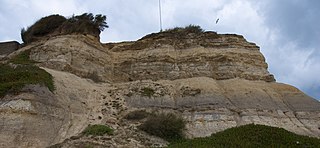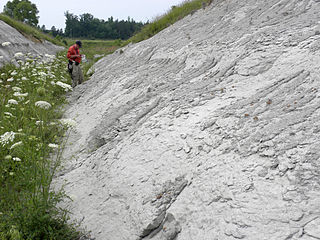
The Wealden Group, occasionally also referred to as the Wealden Supergroup, is a group in the lithostratigraphy of southern England. The Wealden group consists of paralic to continental (freshwater) facies sedimentary rocks of Berriasian to Aptian age and thus forms part of the English Lower Cretaceous. It is composed of alternating sands and clays. The sandy units were deposited in a flood plain of braided rivers, the clays mostly in a lagoonal coastal plain.
Argiles et Grès à Reptiles Formation also known as the Argiles Rutilantes Formation is an early Maastrichtian French geologic formation in the département of Var preserving the remains of several types of dinosaurs and other extinct organisms.
The Bushveld Sandstone is a geological formation dating to roughly between 201 and 189 million years ago and covering the Carnian to Norian stages. The Bushveld Sandstone is found in Transvaal, South Africa, and is a member of the Stormberg Group. As its name suggests, it consists mainly of sandstone. Fossils of the prosauropod dinosaur Massospondylus have been recovered from the Bushveld Sandstone.
The Milk River Formation is a sandstone-dominated stratigraphic unit of the Western Canada Sedimentary Basin in southern Alberta, Canada. It was deposited in near-shore to coastal environments during Late Cretaceous time. Based on uranium-lead dating, palynology and stratigraphic relationships, deposition occurred between ~84.1 and 83.6 Ma.
The Dashuigou Formation is a geological formation in Inner Mongolia, north China, whose strata date back to the Early Cretaceous period.
The Ulansuhai Formation is a geological formation in Inner Mongolia, north China. Dinosaur remains are among the fossils that have been recovered from the formation.
The Bostobe Formation is a geological formation in Qaraghandy & Qyzylorda, Kazakhastan whose strata date back to the Late Cretaceous.

The Selma Group is a geological formation in North America, within the U.S. states of Alabama, Mississippi, and Tennessee. The strata date from the Santonian to the Maastrichtian stages of the Late Cretaceous. The group is composed of, in ascending order, the Mooreville Chalk Formation, Demopolis Chalk Formation, Ripley Formation, and Prairie Bluff Chalk Formation. Dinosaur and mosasaur remains are among the fossils that have been recovered from the Selma Group.
The Tsagaantsav Formation, Tsagantsab Formation or Tsagan-Tsab Formation is an Early Cretaceous geologic formation in Mongolia. Indeterminate sauropod and psittacosaurid remains have been recovered from the formation. Remains of the pterosaur Noripterus, which were originally given their own genus, "Phobetor" have also been recovered from the formation.
The Ankazomihaboka Formation is a Coniacian geologic formation in the Mahajanga Basin of northwestern Madagascar. The formation comprises claystones and sandstones deposited in a fluvial to lacustrine environment. The formation is overlain by the Marovoay Beds and overlies basalt.
The Korycanar Formation is a Late Cretaceous geologic formation in the Czech Republic. Archosauromorph remains diagnostic to the genus level are among the fossils that have been recovered from the formation and also dinosaur remains are among the fossils that have been recovered from the formation, although none have yet been referred to a specific genus.
The Andaikhudag Formation, in older literature referred to as Unduruh Formation or Ondorukhaa Formation, is an Early Cretaceous geologic formation in Mongolia. Dinosaur remains diagnostic to the genus level are among the fossils that have been recovered from the formation.
The Turginskaya Svita is an Early Cretaceous period geologic formation located in Russia. Dinosaur remains were recovered from it as early as 1915, including partial theropod remains.

